Chemical and Microbial Leaching of Valuable Metals from PCBs and Tantalum Capacitors of Spent Mobile Phones
Abstract
:1. Introduction
2. Materials and Methods
2.1. Material Characterization
2.2. Microorganism and Culture Conditions
2.3. Metal Leaching Experiments
2.3.1. Leaching with Organic and Inorganic Acids
2.3.2. Microbial Leaching Studies
3. Results
3.1. Characterisation of Samples
3.2. Leaching Experiments
3.2.1. Leaching with Organic Acids
3.2.2. Leaching with Inorganic Acids
3.2.3. Microbial Leaching
4. Discussion
4.1. Metal Extraction by Organic Acid Leaching
4.2. Metal Extraction by Inorganic Acid Leaching
4.3. Metal Extraction by Acidophilic Bacterial Strains
4.4. Metal Extraction by Fungal Leaching
4.5. Comparative Evaluation of Chemical and Microbial Leaching of Metals
5. Conclusions
Supplementary Materials
Author Contributions
Funding
Institutional Review Board Statement
Informed Consent Statement
Data Availability Statement
Acknowledgments
Conflicts of Interest
References
- Tuncuk, A.; Stazi, V.; Akcil, A.; Yazici, E.Y.; Deveci, H. Aqueous metal recovery techniques from e-scrap: Hydrometallurgy in recycling. Miner. Eng. 2012, 25, 28–37. [Google Scholar] [CrossRef]
- Lee, J.; Pandey, B. Bio-processing of solid wastes and secondary resources for metal extraction–A review. Waste Manag. 2012, 32, 3–18. [Google Scholar] [CrossRef] [PubMed]
- D’Adamo, I.; Ferella, F.; Gastaldi, M.; Maggiore, F.; Rosa, P.; Terzi, S. Towards sustainable recycling processes: Wasted printed circuit boards as a source of economic opportunities. Resour. Conserv. Recycl. 2019, 149, 455–467. [Google Scholar] [CrossRef]
- Binnemans, K.; Jones, P.T.; Blanpain, B.; Van Gerven, T.; Yang, Y.; Walton, A.; Buchert, M. Recycling of rare earths: A critical review. J. Clean. Prod. 2013, 51, 1–22. [Google Scholar] [CrossRef]
- Cui, J.; Zhang, L. Metallurgical recovery of metals from electronic waste: A review. J. Hazard. Mater. 2008, 158, 228–256. [Google Scholar] [CrossRef]
- Cui, J.; Forssberg, E. Mechanical recycling of waste electric and electronic equipment: A review. J. Hazard. Mater. 2003, 99, 243–263. [Google Scholar] [CrossRef]
- Zhang, L.; Xu, Z. A review of current progress of recycling technologies for metals from waste electrical and electronic equipment. J. Clean. Prod. 2016, 127, 19–36. [Google Scholar] [CrossRef]
- Khaliq, A.; Rhamdhani, M.A.; Brooks, G.; Masood, S. Metal extraction processes for electronic waste and existing industrial routes: A review and Australian perspective. Resources 2014, 3, 152–179. [Google Scholar] [CrossRef]
- Yang, X.; Sun, L.; Xiang, J.; Hu, S.; Su, S. Pyrolysis and dehalogenation of plastics from waste electrical and electronic equipment (WEEE): A review. Waste Manag. 2013, 33, 462–473. [Google Scholar] [CrossRef]
- Gahan, C.; Srichandan, H.; Kim, J.D.; Akcil, A. Biohydrometallurgy and biomineral processing technology: A Review on its past, present and future. Res. J. Recent Sci. 2012, 1, 85–99. [Google Scholar]
- Sukla, L.; Esther, J.; Panda, S.; Pradhan, N. Biomineral processing: A valid eco-friendly alternative for metal extraction. Res. Rev. J. Microbiol. Biotechnol. 2014, 3, 1–10. [Google Scholar]
- Debnath, B.; Chowdhury, R.; Ghosh, S.K. Sustainability of metal recovery from E-waste. Front. Environ. Sci. Eng. 2018, 12, 1–12. [Google Scholar] [CrossRef]
- You, J.; Solongo, S.K.; Gomez-Flores, A.; Choi, S.; Zhao, H.; Urik, M. Intensified bioleaching of chalcopyrite concentrate using adapted mesophilic culture in continuous stirred tank reactors. Bioresour. Technol. 2020, 307, 123181. [Google Scholar] [CrossRef] [PubMed]
- Ilyas, S.; Chi, R.; Bhatti, H.N.; Bhatti, I.A.; Ghauri, M.A. Column bioleaching of low-grade mining ore containing high level of smithsonite, talc, sphaerocobaltite and azurite. Bioprocess Biosyst. Eng. 2012, 35, 433–440. [Google Scholar] [CrossRef]
- Rotter, V.S.; Flamme, S. Recycling of highly functional and strategically important metals from WEEE- Current status and future perspectives. In Proceedings of the 12th International Electronics Recycling Congress IERC 2013, Salzburg, Austria, 16–18 January 2013. [Google Scholar]
- Kinsman, L.M.M.; Rosa, A.M.C.; Amrita, S.; Morgan, B.T.N.; Carole, A.M.; Jason, B.L. Tantalum Recycling by Solvent Extraction: Chloride Is Better than Fluoride. Metals 2020, 10, 346. [Google Scholar] [CrossRef]
- Nguyen, T.H.; Lee, M.S. A review on the separation of niobium and tantalum by solvent extraction. Miner. Process. Extr. Met. Rev. 2019, 40, 265–277. [Google Scholar] [CrossRef]
- Kabangu, M.J.; Crouse, P.L. Separation of niobium and tantalum from Mozambican tantalite by ammonium bifluoride digestion and octanol solvent extraction. Hydrometallurgy 2012, 129, 151–155. [Google Scholar] [CrossRef]
- Zhu, Z.; Cheng, C.Y. Solvent extraction technology for the separation and purification of niobium and tantalum: A review. Hydrometallurgy 2011, 107, 1–12. [Google Scholar] [CrossRef]
- Dopson, M.; Ossandon, F.; Lövgren, L.; Holmes, D. Metal resistance or tolerance? Acidophiles confront high metal load via both abiotic and biotic mechanisms. Front. Microbiol. 2014, 5, 157. [Google Scholar] [CrossRef]
- Panda, S.; Rout, P.C.; Sarangi, C.K.; Mishra, S.; Pradhan, N.; Mohapatra, U.; Subbaiah, T.; Sukla, L.B.; Mishra, B.K. Recovery of copper from a surface altered chalcopyrite contained ball mill spillage through bio-hydrometallurgical route. Korean J. Chem. Eng. 2014, 31, 452–460. [Google Scholar] [CrossRef]
- Islam, A.; Ahmed, T.; Awual, M.R.; Rahman, A.; Sultana, M.; Aziz, A.A.; Monir, M.U.; Teo, S.H.; Hasan, M. Advances in sustainable approaches to recover metals from e-waste—A review. J. Clean. Prod. 2020, 244, 118815. [Google Scholar] [CrossRef]
- Brandl, H.; Lehmann, S.; Faramarzi, M.A.; Martinelli, D. Biomobilization of silver, gold, and platinum from solid waste materials by HCN-forming microorganisms. Hydrometallurgy 2008, 4, 14–17. [Google Scholar] [CrossRef]
- Ilyas, S.; Kim, M.-S.; Lee, J.-C.; Jabeen, A.; Bhatti, H. Bio-reclamation of strategic and energy critical metals from secondary resources. Metals 2017, 7, 207. [Google Scholar] [CrossRef]
- Hao, J.; Wang, X.; Wang, Y.; Wu, Y.; Guo, F. Optimizing the leaching parameters and studying the kinetics of copper recovery from waste printed circuit boards. ACS Omega 2022, 7, 3689–3699. [Google Scholar] [CrossRef] [PubMed]
- Kumar, M.; Lee, J.; Kim, M.S.; Jeong, J.; Yoo, K. Leaching of metals from waste printed circuit boards (WPCBs) using sulphuric and nitric acids. Environ. Eng. Manag. J. 2014, 13, 2601–2607. [Google Scholar]
- Srivastava, R.R.; Pathak, P. Policy issues for efficient management of E-waste in developing countries. In Handbook of Electronic Waste Management; Prasad, M.N.V., Vithanage, M., Borthakur, A., Eds.; Butterworth-Heinemann: Oxford, UK, 2020; pp. 81–99. [Google Scholar]
- Balcerzak, M.; Marczenko, Z. Seperation, Preconcentration and Spectrophotometry in Inorganic Analysis. In Analytical Spectroscopy Library; Elsevier: Amsterdam, The Netherlands, 2000. [Google Scholar]
- Brandl, H.; Bosshard, R.; Wegmann, M. Computer-munching microbes: Metal leaching from electronic scrap by bacteria and fungi. Hydrometallurgy 2001, 59, 319–326. [Google Scholar] [CrossRef]
- Isildar, A. Biological versus Chemical Leaching of Electronic Waste for Copper and Gold Recovery. Ph.D. Thesis, Universite Paris EST and UNISCO-IHE, Paris, France, 2016. [Google Scholar]
- Amiri, F.; Mousavi, S.M.; Yaghmaei, S.; Barati, M. Bioleaching kinetics of a spent refinery catalyst using Aspergillus niger at optimal conditions. Biochem. Eng. J. 2012, 67, 208–217. [Google Scholar] [CrossRef]
- Santhiya, D.; Ting, Y.-P. Bioleaching of spent refinery processing catalyst using Aspergillus niger with high-yield oxalic acid. J. Biotechnol. 2005, 116, 171–184. [Google Scholar] [CrossRef]
- Aung, K.M.M.; Ting, Y.-P. Bioleaching of spent fluid catalytic cracking catalyst using Aspergillus niger. J. Biotechnol. 2005, 116, 159–170. [Google Scholar] [CrossRef]
- Ajiboye, E.A.; Panda, P.K.; Adebayo, A.O.; Ajayi, O.O.; Tripathy, B.C.; Ghosh, M.K.; Basu, S. Leaching kinetics of Cu, Ni and Zn from waste silica rich integrated circuits using mild nitric acid. Hydrometallurgy 2019, 188, 161–168. [Google Scholar] [CrossRef]
- Hong, Y.; Valix, M. Bioleaching of electronic waste using acidophilic sulfur oxidising bacteria. J. Clean. Prod. 2014, 65, 465–472. [Google Scholar] [CrossRef]
- Apel, A.W.; Dugan, R.P. Hydrogen ion utilization by iron grown Thiobacillus ferrooxidans. In Metallurgical Applications of Bacterial Leaching and Related Microbiological Phenomena, 1st ed.; Murr, E.L., Torma, A.E., Brierley, A.J., Eds.; Academic Press: New York, NY, USA; San Francisco, CA, USA; London, UK, 1978; pp. 45–58. [Google Scholar]
- Zhang, B.; Wang, L.; Cao, Z.; Kozlov, S.M.; De Arquer, F.P.G.; Dinh, C.T.; Li, J.; Wang, Z.; Zheng, X.; Zhang, L.; et al. High-valence metals improve oxygen evolution reaction performance by modulating 3d metal oxidation cycle energetics. Nat. Catal. 2020, 3, 985–992. [Google Scholar] [CrossRef]
- Chancerel, P.; Rotter, V.S. Recycling-oriented characterization of small waste electrical and electronic equipment. Waste Manag. 2009, 29, 2336–2352. [Google Scholar] [CrossRef] [PubMed]
- Rawlings, D.E. Characteristics and Adaptability of Iron- and Sulfur-Oxidizing Microorganisms Used for the Recovery of Metals from Minerals and Their Concentrates. Microb. Cell Factories 2005, 4, 13. [Google Scholar] [CrossRef]
- Faraji, F.; Golmohammadzedeh, R.; Rashchi, F.; Alimardani, N. Fungal bioleaching of WPCBs using Aspergillus niger: Observation, optimization and kinetics. J. Environ. Manag. 2018, 217, 775–787. [Google Scholar] [CrossRef]
- Tong, Z.; Zheng, X.; Tong, Y.; Shi, Y.-C.; Sun, J. Systems metabolic engineering for citric acid production by Aspergillus niger in the post-genomic era. Microb. Cell Factories 2019, 18, 28. [Google Scholar] [CrossRef]
- Erust, C.; Akcil, A.; Tuncuk, A.; Panda, S. Intensified acidophilic bioleaching of multi- metals from waste printed circuit boards (WPCB) of spent mobile phones. J. Chem. Technol. Biotechnol. 2020, 95, 2272–2285. [Google Scholar] [CrossRef]
- Xu, T.-J.; Ting, Y.-P. Optimization on bioleaching of incinerator fly ash by Aspergillus niger—Use of central composite design. Enzym. Microb. Technol. 2004, 35, 444–454. [Google Scholar] [CrossRef]
- Santaolalla, A.; Lens, P.N.L.; Barona, A.; Rojo, N.; Ocio, A.; Gallastegui, G. Metal Extraction and Recovery from Mobile Phone PCBs by a Combination of Bioleaching and Precipitation Processes. Minerals 2021, 11, 1004. [Google Scholar] [CrossRef]
- Castro, I.M.; Fietto, J.L.R.; Vieira, R.X.; Tropia, M.J.M.; Campos, L.M.M.; Paniago, E.B.; Brandao, R.L. Bioleaching of zinc and nickel from silicates using Aspergillus niger cultures. Hydrometallurgy 2000, 57, 39–49. [Google Scholar] [CrossRef]
- Pant, D.; Joshi, D.; Upreti, M.K.; Kotnala, R.K. Chemical and biological extraction of metals present in E waste: A hybrid technology. Waste Manag. 2012, 32, 979–990. [Google Scholar] [CrossRef] [PubMed]
- Navarro, C.A.; Von Bernath, D.; Jerez, C.A. Heavy metal resistance strategies of Acidophillic bacteria and their aquisation: Importance for biomining and bioremediation. Biol. Res. 2013, 46, 363–371. [Google Scholar] [CrossRef] [PubMed]
- Funari, V.; Mäkinen, J.; Salminen, J.; Braga, R.; Dinelli, E.; Revitzer, H. Metal removal from Municipal Solid Waste Incineration fly ash: A comparison between chemical leaching and bioleaching. Waste Manag. 2017, 60, 397–406. [Google Scholar] [CrossRef] [PubMed]
- Doku, T.E.; Belford, E.J.D. The potential of Aspergillus fumigatus and Aspergillus niger in bioaccumulation of heavy metals from the Chemu Lagoon, Ghana. J. Appl. Biosci. 2015, 94, 8907–8914. [Google Scholar] [CrossRef]
- Vyas, S.; Ting, Y.-P. Sequential biological process for molybdenum extraction from hydrodesulphurization spent catalyst. Chemosphere 2016, 160, 7–12. [Google Scholar] [CrossRef]
- Srichandan, H.; Pathak, A.; Singh, S.; Blight, K.; Kim, D.-J.; Lee, S.-W. Sequential leaching of metals from spent refinery catalyst in bioleaching–bioleaching and bioleaching–chemical leaching reactor: Comparative study. Hydrometallurgy 2014, 150, 130–143. [Google Scholar] [CrossRef]



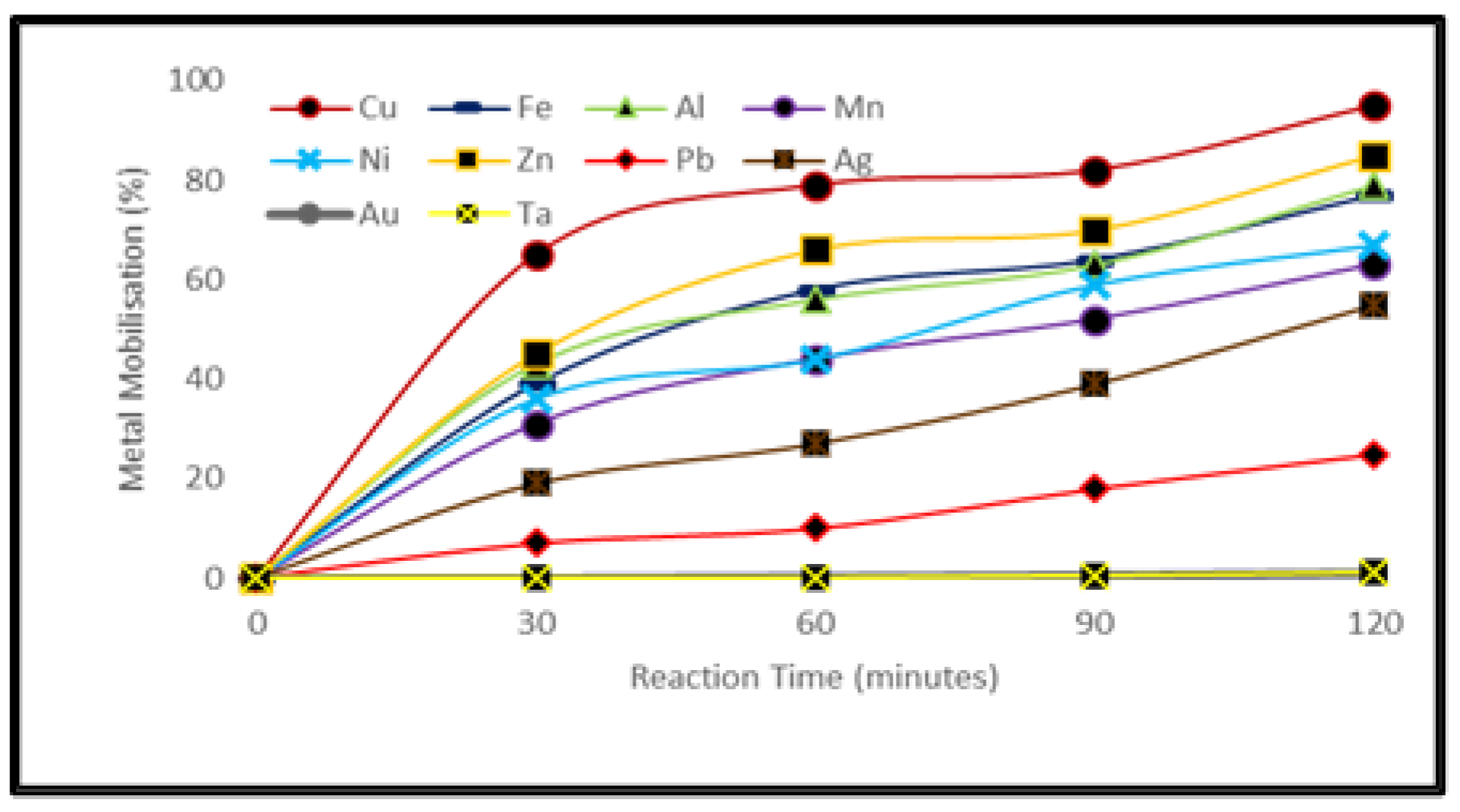
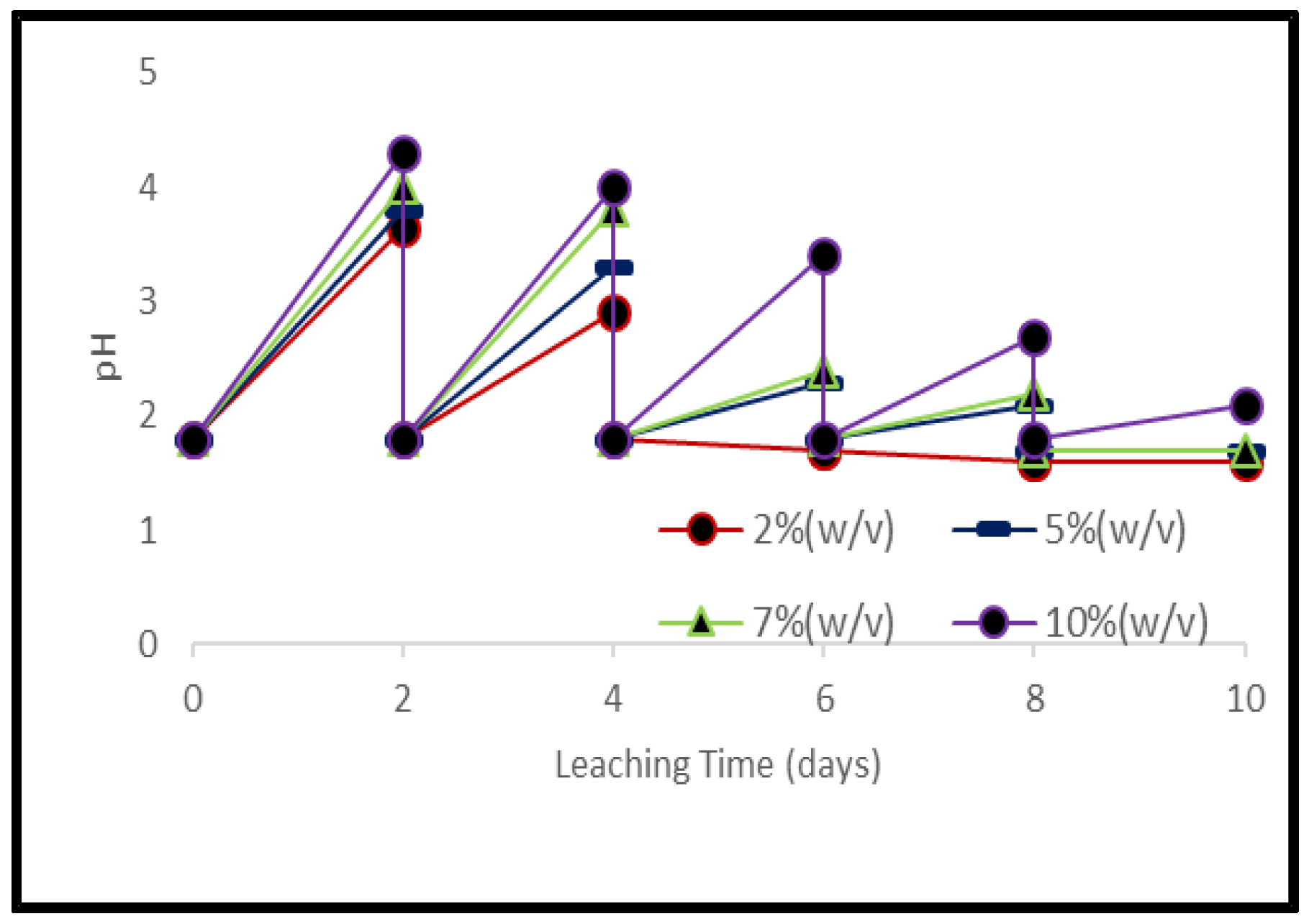
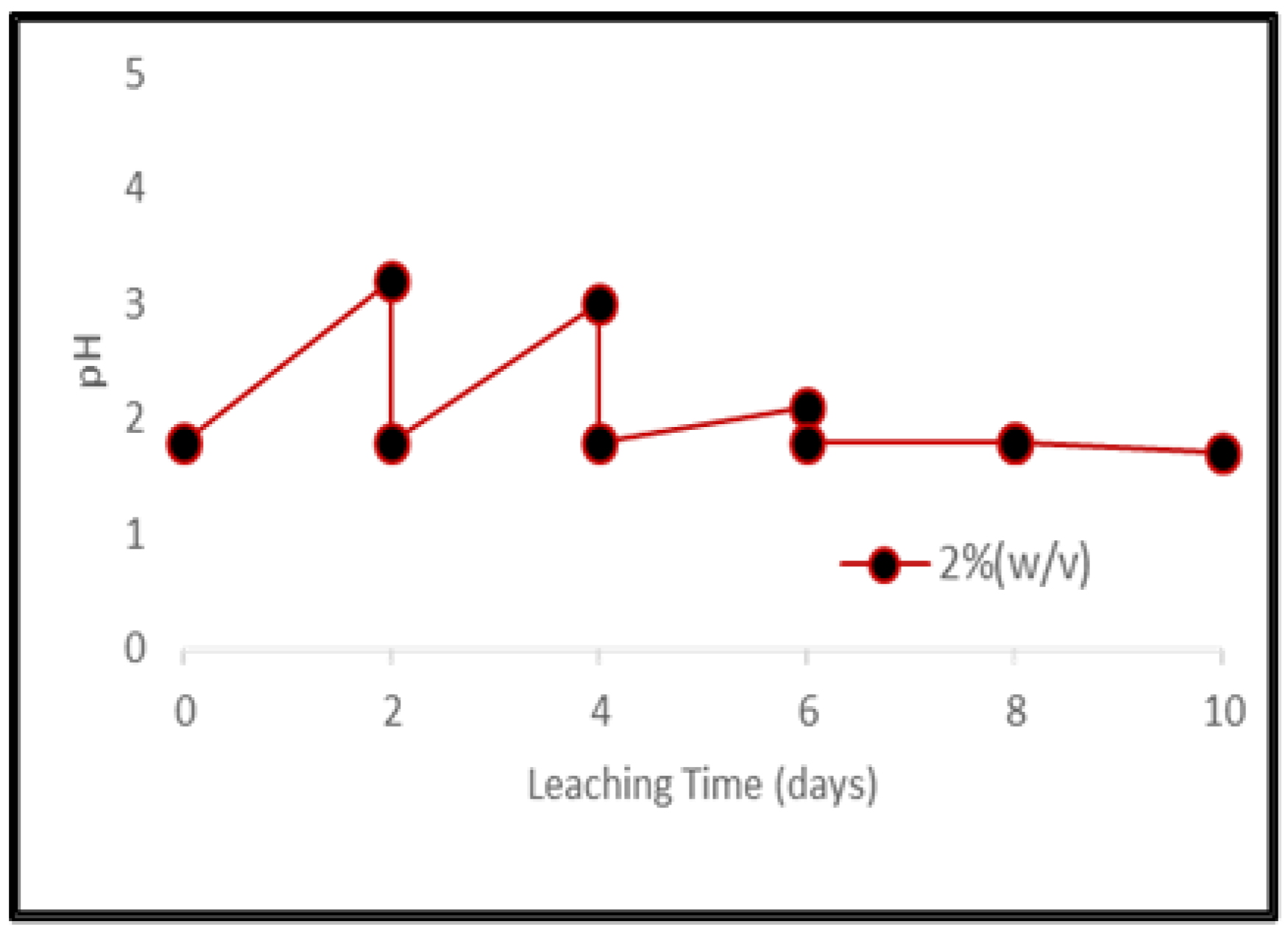

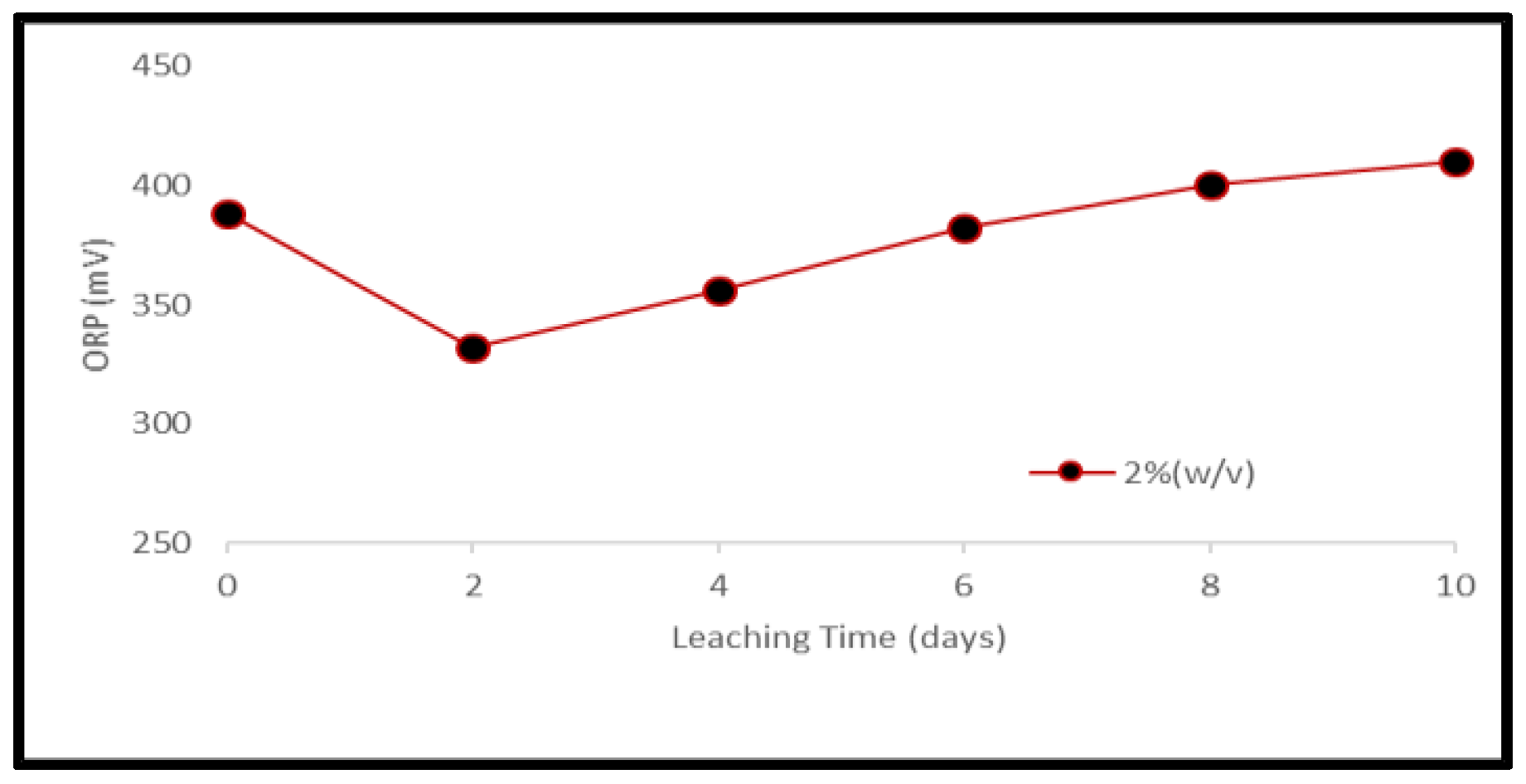
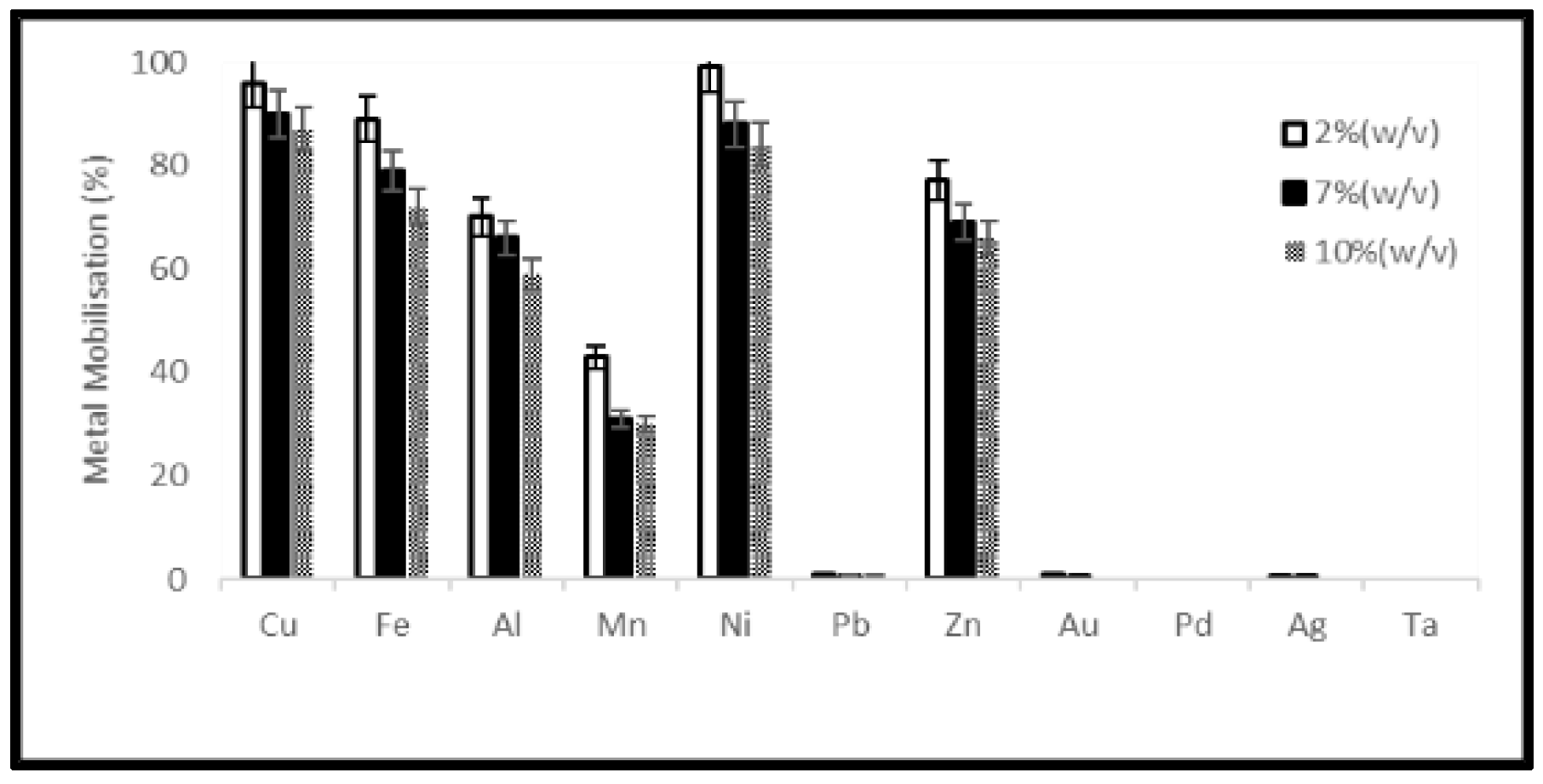
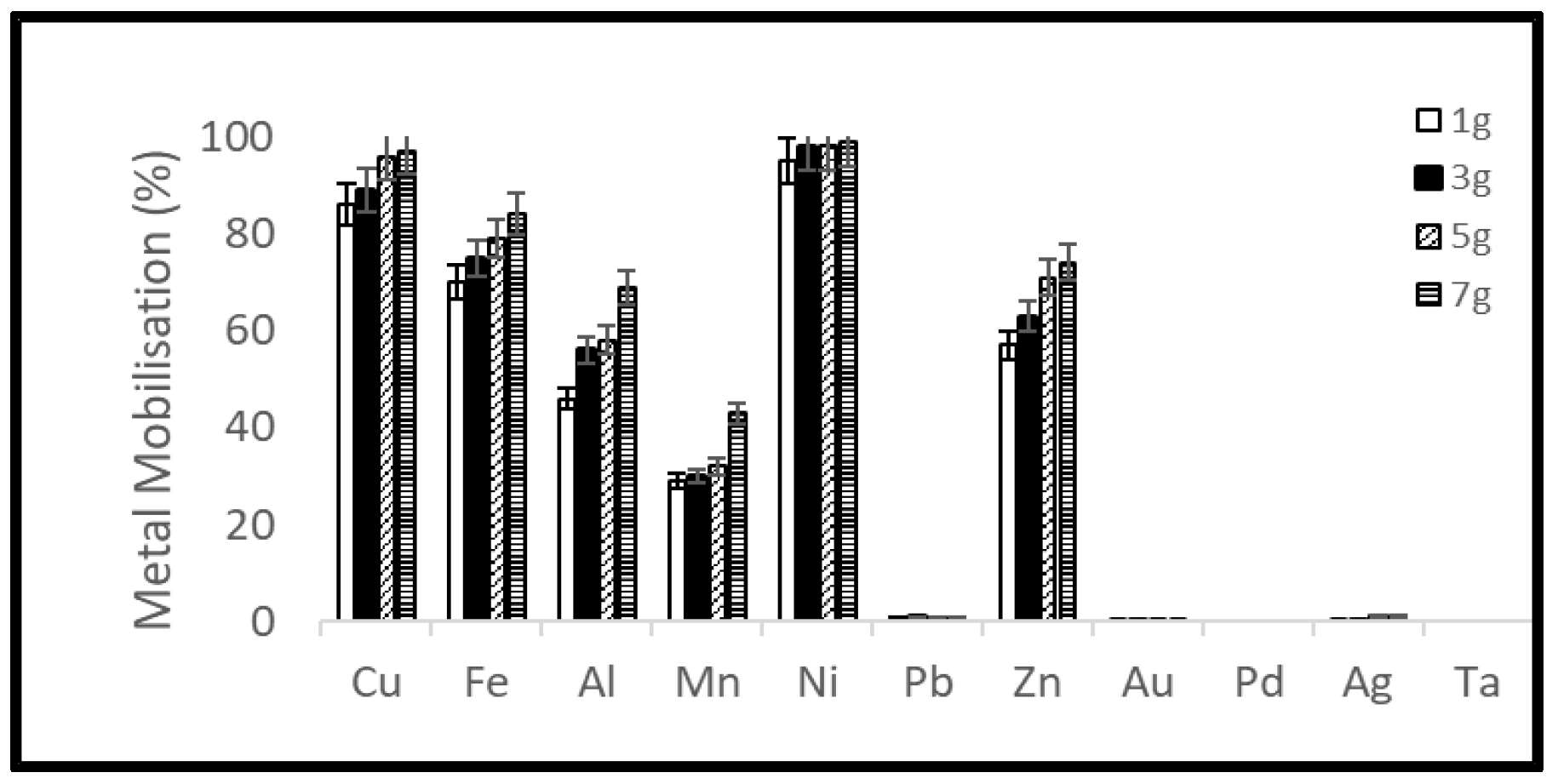
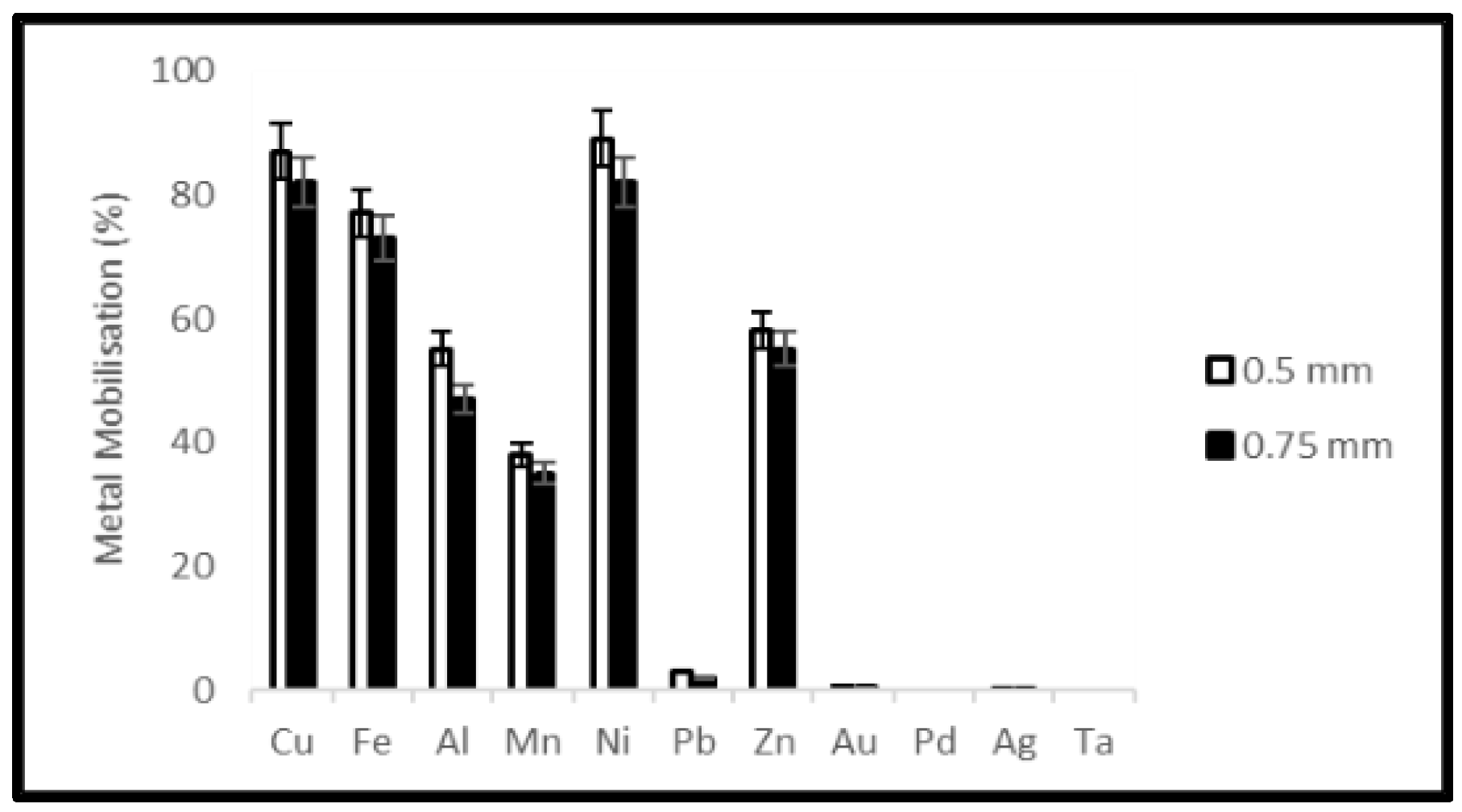

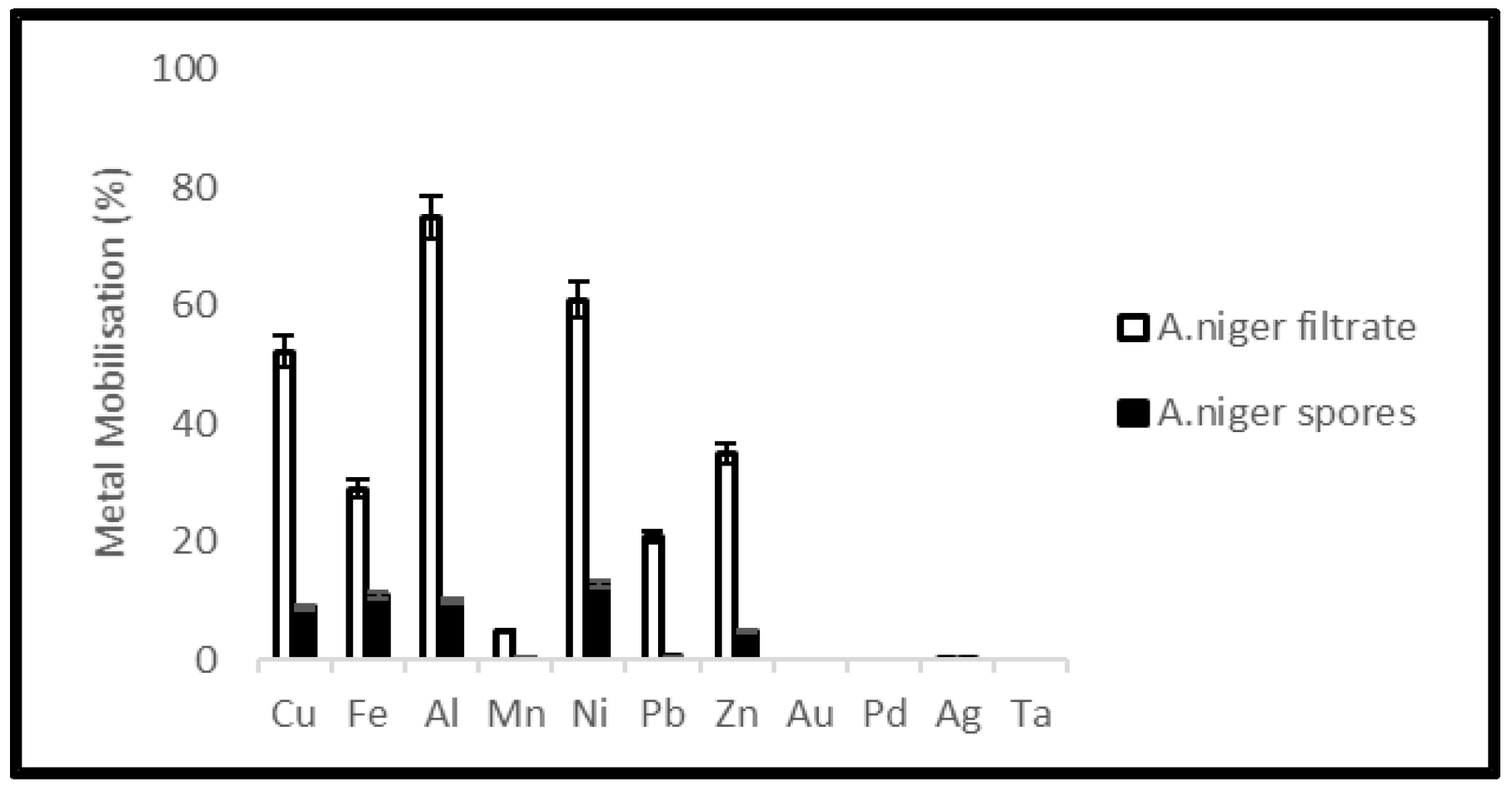
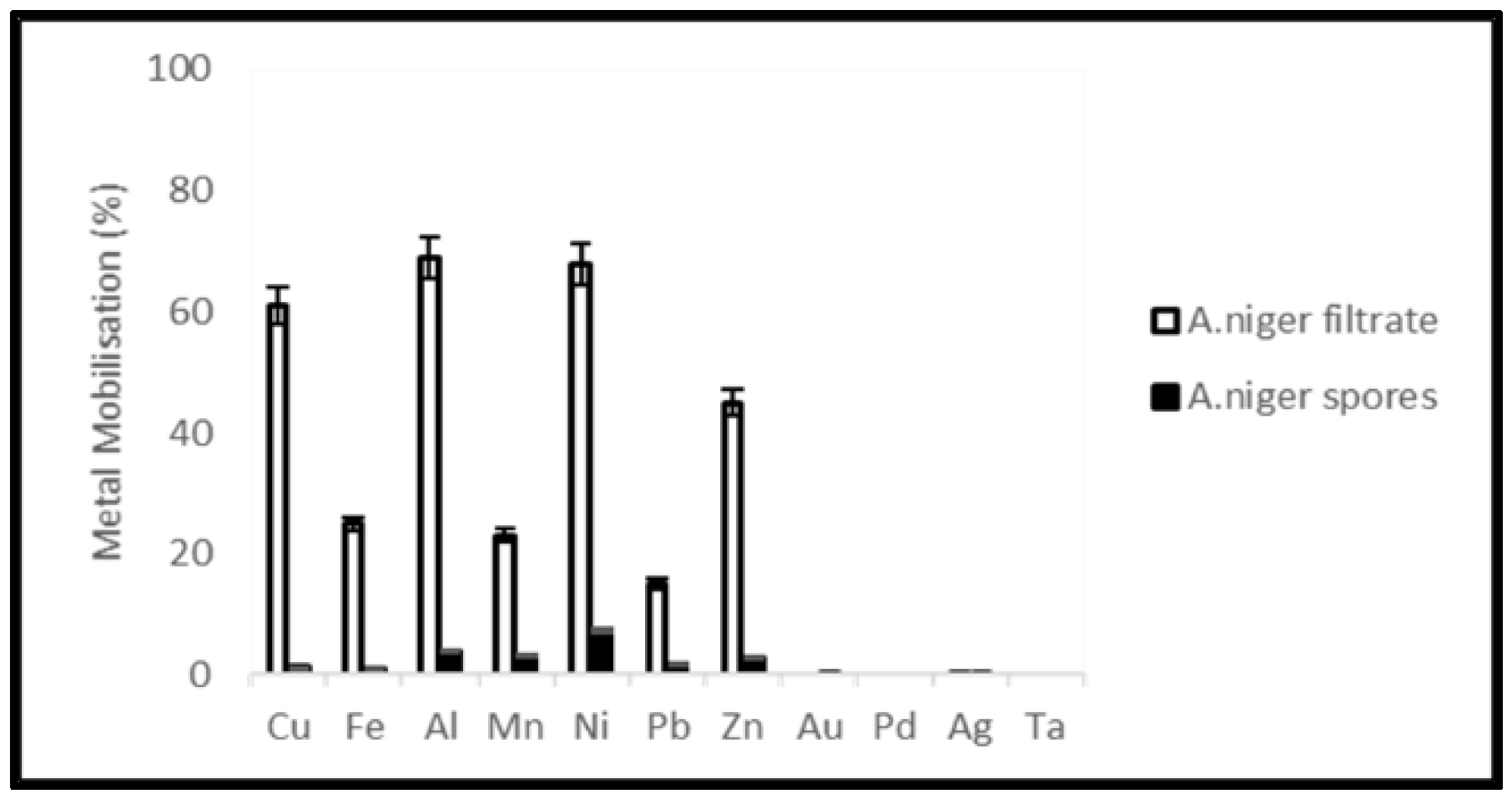

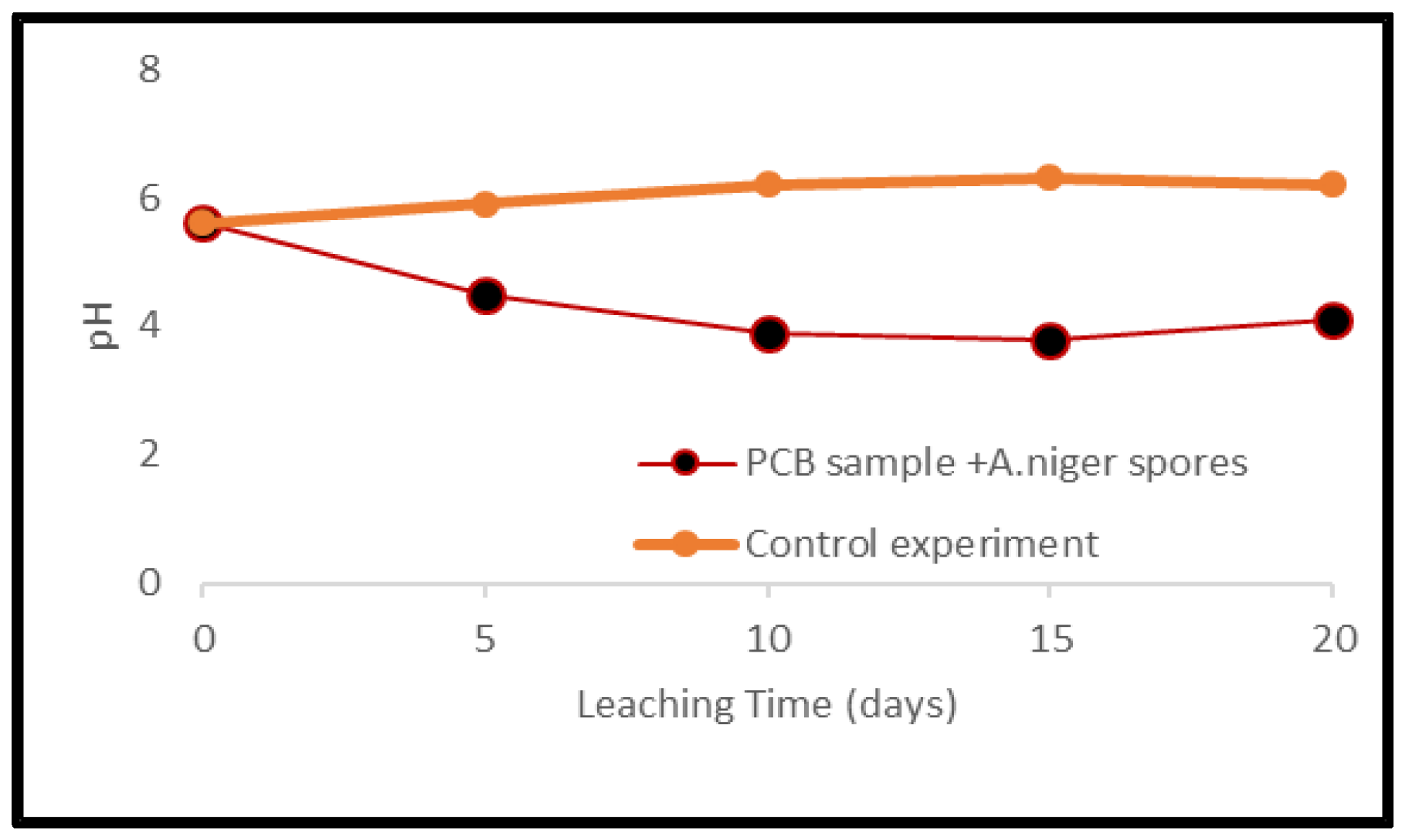
| PCBs (Mobile) Microwave Digestion without HF | Ta. Capacitors Microwave Digestion with HF | |||||||
|---|---|---|---|---|---|---|---|---|
| Particle Size | Particle Size | |||||||
| 0.75 | 0.5 | 0.75 | 0.5 | |||||
| Base Metals (g/Kg) | Average | SD | Average | SD | Average | SD | Average | SD |
| Cu | 311.6 | 5.32 | 267.6 | 4.87 | 53.5 | 1.51 | 66.3 | 1.55 |
| Fe | 50.6 | 0.87 | 17.9 | 0.41 | 4.7 | 0.02 | 12.2 | 0.04 |
| Al | 8.7 | 0.34 | 10.6 | 0.39 | 3.9 | 0.01 | 4.6 | 0.01 |
| Mn | 13.5 | 0.51 | 8.7 | 0.33 | 82.3 | 1.91 | 53.9 | 1.72 |
| Ni | 22.3 | 1.23 | 30.17 | 1.51 | 14.3 | 0.43 | 24.3 | 0.54 |
| Pb | 10.5 | 0.76 | 8.9 | 0.41 | 14 | 0.81 | 14.7 | 0.77 |
| Zn | 35.1 | 1.59 | 25.4 | 1.38 | 6.2 | 0.24 | 8.8 | 0.28 |
| Precious Metals (g/Kg) | ||||||||
| Au | 0.4 | 0 | 0.9 | 0 | 0.05 | 0 | 0.06 | 0 |
| Pd | 0.1 | 0 | 0.1 | 0 | 0.2 | 0 | 0.1 | 0 |
| Ag | 2.2 | 0.02 | 1.4 | 0.01 | 14.9 | 0.21 | 19.9 | 0.27 |
| Critical Metal (g/Kg) | ||||||||
| Ta | 0.03 | 0 | 0.03 | 0 | 292.5 | 2.32 | 292.5 | 2.32 |
| Sample | Base Metals (g/Kg) | Precious Metals (g/Kg) | Critical Metal (g/Kg) | References | ||||||||
|---|---|---|---|---|---|---|---|---|---|---|---|---|
| Cu | Fe | Al | Mn | Ni | Pb | Zn | Au | Pd | Ag | Ta | ||
| PCBs from spent mobile phones | 311.6 | 50.6 | 8.7 | 13.5 | 22.3 | 10.5 | 35.1 | 0.4 | 0.1 | 2.2 | 0.03 | Present Study |
| 378.1 | 48.5 | 6.1 | NR | 25.4 | 12.3 | 18.2 | 0.9 | NR | 0.5 | NR | [29] | |
| 344.9 | 105.7 | 2.6 | NR | 26.3 | 18.7 | 59.2 | NR | NR | 2.1 | NR | [30] | |
| 566.8 | 2.4 | 14.2 | NR | NR | NR | 2.2 | 0.2 | 0.1 | 1.0 | NR | [31] | |
| 360.0 | 10.5 | 6.7 | NR | 8.6 | 12.1 | 8.0 | 0.1 | 0.6 | 0.3 | NR | [32] | |
| Ta Capacitor (Old and new) | 53.5 | 28.7 | 3.9 | 82.3 | 14.3 | 14.0 | 6.2 | 0.05 | 0.2 | 14.9 | 292.5 | Present Study |
| 38 | 38 | 21.1 | 31.8 | 21.7 | 1.3 | 2.8 | 0.01 | ND | 32 | 484 | [33] | |
| NR | NR | NR | 175 | NR | NR | NR | NR | NR | 33 | 442 | [25] | |
| Leaching Agent | Acid Conc. (M) | pH | Particle Size (mm) | Pulp Density (%) | Temp (°C) | Time | Leaching Efficiency (%) | |||||||||||
|---|---|---|---|---|---|---|---|---|---|---|---|---|---|---|---|---|---|---|
| Cu | Fe | Al | Mn | Ni | Pb | Zn | Au | Pd | Ag | Ta | ||||||||
| Organic Acids | Citric Acid | 0.05 | - | 0.75 | 10 | 30 | 20 days | 45 | 14 | 58 | 11 | 35 | 48 | 45 | 0 | 0 | 0.2 | 0 |
| Oxalic Acid | 0.05 | - | 0.75 | 10 | 30 | 20 days | 16 | 8 | 19 | 4 | 11 | 3 | 2 | 0 | 0 | 0 | 0 | |
| Inorganic Acids | Sulfuric Acid | 2 | - | 0.75 | 10 | 85 | 4 h | 98 | 68 | 77 | 48 | 75 | 5 | 87 | 0.1 | 0 | 0.4 | 0 |
| Nitric Acid | 4 | - | 0.75 | 10 | 80 | 2 h | 95 | 77 | 79 | 63 | 67 | 25 | 85 | 1.1 | 0 | 55 | 1.3 | |
| Microorganisms | Mixed Consortium (A. ferrooxidans, L. ferrooxidans and A. thiooxidan) | - | 1.8 | 0.75 | 2 | 30 | 10 days | 96 | 89 | 70 | 43 | 99 | 0.8 | 77 | 0.8 | 0 | 0 | 0 |
| A. niger (spores) | - | 5.6 | 0.75 | 2 | 30 | 10 days | 9 | 11 | 10 | 0.4 | 13 | 0.6 | 5 | 0 | 0 | 0 | 0 | |
| A. niger (filtrate) | - | 5.6 | 0.75 | 2 | 30 | 10 days | 52 | 29 | 75 | 5 | 61 | 21 | 35 | 0 | 0 | 0.2 | 0 | |
Publisher’s Note: MDPI stays neutral with regard to jurisdictional claims in published maps and institutional affiliations. |
© 2022 by the authors. Licensee MDPI, Basel, Switzerland. This article is an open access article distributed under the terms and conditions of the Creative Commons Attribution (CC BY) license (https://creativecommons.org/licenses/by/4.0/).
Share and Cite
Sikander, A.; Kelly, S.; Kuchta, K.; Sievers, A.; Willner, T.; Hursthouse, A.S. Chemical and Microbial Leaching of Valuable Metals from PCBs and Tantalum Capacitors of Spent Mobile Phones. Int. J. Environ. Res. Public Health 2022, 19, 10006. https://doi.org/10.3390/ijerph191610006
Sikander A, Kelly S, Kuchta K, Sievers A, Willner T, Hursthouse AS. Chemical and Microbial Leaching of Valuable Metals from PCBs and Tantalum Capacitors of Spent Mobile Phones. International Journal of Environmental Research and Public Health. 2022; 19(16):10006. https://doi.org/10.3390/ijerph191610006
Chicago/Turabian StyleSikander, Asma, Steven Kelly, Kerstin Kuchta, Anika Sievers, Thomas Willner, and Andrew S. Hursthouse. 2022. "Chemical and Microbial Leaching of Valuable Metals from PCBs and Tantalum Capacitors of Spent Mobile Phones" International Journal of Environmental Research and Public Health 19, no. 16: 10006. https://doi.org/10.3390/ijerph191610006
APA StyleSikander, A., Kelly, S., Kuchta, K., Sievers, A., Willner, T., & Hursthouse, A. S. (2022). Chemical and Microbial Leaching of Valuable Metals from PCBs and Tantalum Capacitors of Spent Mobile Phones. International Journal of Environmental Research and Public Health, 19(16), 10006. https://doi.org/10.3390/ijerph191610006








